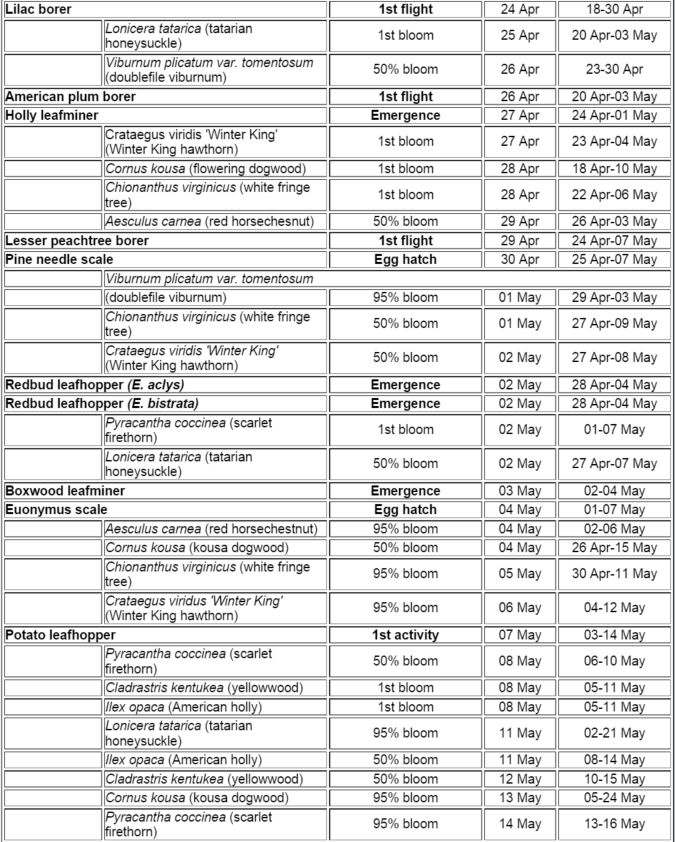Timing Control Actions for Landscape Insect Pests Using Flowering Plants as Indicators
ENT-66: Timing Control Actions for Landscape Insect Pests Using Flowering Plants as Indicators | Download PDF
by D.A. Potter and G.J. Mussey, Entomologists
University of Kentucky College of Agriculture
Landscape managers in Kentucky contend with a wide vari- ety of plants and associated pest problems. In any given landscape, there may be hundreds of species and cultivars of native and exotic trees, shrubs, and garden plants. Throughout the growing season, these plants may be attacked by a similarly diverse assortment of insects, including wood borers, leafminers, scale insects, plant bugs, and leaf-feeding caterpillars.
Timing is everything when managing landscape pests. To be effective, insecticides or biological controls must be applied when pests are present and at their most vulnerable life stage. For example, scale insects are best controlled after the eggs have hatched but before the crawlers have formed a protective cover. Controlling wood borers requires treating host trees with insecticides to intercept the newly hatched larvae before they have penetrated the bark. Leaf-feeding caterpillars such as bagworms and tent caterpillars are easiest to control when the larvae are small. Timing is especially important when using short-lived materials such as summer oils, soaps, and Bacillus thuringiensis (BT).
Frequent in-field inspection is the most reliable means to detect insect problems and time control efforts. Unfortunately, regular monitoring is too time-consuming for many landscape managers. Field workers may not know when or where to look for vulnerable life stages or may not recognize them when encountered. Pests such as the holly leafminer, honeylocust plant bug, and potato leafhopper feed in advance of any recognizable damage. Pheromone traps are available for monitoring certain insects (e.g., clearwing borers) but require time and expertise to use effectively.
Forecasting Using Plant Phenology
Phenology is the science dealing with the effects of climate on seasonal biological events, including plant flowering and insect emergence. Insects are cold-blooded, and like plants, their development will be earlier or later depending on spring temperatures. Since both plant and insect development are temperature-dependent, seasonal appearance of particular insect pests should follow a predictable sequence correlated with the flowering of particular landscape plants. In a three-year research project, the seasonal development and emergence of 33 important insect pests were systematically monitored and tracked resulting in the creation of the timetable below. This information will help landscape managers and lay persons anticipate the appearance of important insect pests and effectively schedule control measures.
Using the Table
Beginning in early spring, the table predicts the sequence and date of emergence of particular insect pests of woody plants or turf (in bold type). Seasonal emergence of each pest is correlated with the flowering of 34 familiar landscape plants. First bloom (when a plant produces its first flower), 50 percent bloom, and 95 percent bloom (essentially full flower) are included to delineate distinct stages of flowering in the landscape. The table also lists average calendar dates of pest emergence during the three-year study, along with the range. Flowering tended to be a more reliable indicator of insect emergence than calendar date due to year-to-year temperature fluctuations.
Locate the pest you wish to monitor in the first column of the table. Flowering events that coincide with that pest's emergence appear in the same vicinity (above and below) of the table.




Determining Treatment Date
For most insects listed in the table, the ideal time to begin insecticide treatment is at or shortly after pest emergence. For bagworms, delay treatment one to two weeks after eggs hatch to ensure all young larvae have emerged from the old bags. For clearwing borers (dogwood, lilac, peachtree, lesser peachtree) and American plum borer, apply a bark spray 10 to 14 days after first flight. Apply a second bark spray one month later for better control of dogwood, peachtree, and lesser peachtree borers. For flatheaded borers (bronze birch borer, flatheaded appletree, honeylocust, twolined chestnut borer), apply a bark spray at or shortly after emergence and repeat after three weeks.
Revised: 4/07
CAUTION! Pesticide recommendations in this publication are registered for use in Kentucky, USA ONLY! The use of some products may not be legal in your state or country. Please check with your local county agent or regulatory official before using any pesticide mentioned in this publication.
Of course, ALWAYS READ AND FOLLOW LABEL DIRECTIONS FOR SAFE USE OF ANY PESTICIDE!
Images: University of Kentucky Entomology
